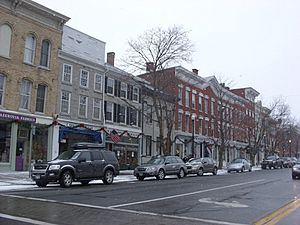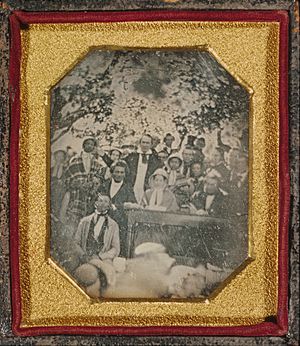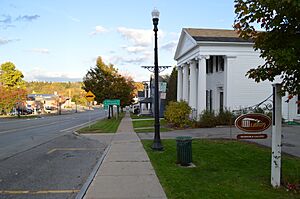Cazenovia (village), New York facts for kids
Quick facts for kids
Cazenovia, New York
|
|
|---|---|
|
Village
|
|

Downtown Cazenovia in Winter 2008
|
|
| Country | United States |
| State | New York |
| County | Madison |
| Area | |
| • Total | 1.89 sq mi (4.89 km2) |
| • Land | 1.89 sq mi (4.89 km2) |
| • Water | 0.00 sq mi (0.00 km2) |
| Elevation | 1,224 ft (373 m) |
| Population
(2020)
|
|
| • Total | 2,767 |
| • Density | 1,466.35/sq mi (566.06/km2) |
| Time zone | UTC-5 (Eastern (EST)) |
| • Summer (DST) | UTC-4 (EDT) |
| ZIP code |
13035
|
| Area code(s) | 315 |
| FIPS code | 36-13145 |
| GNIS feature ID | 0946090 |
Cazenovia is a small village in Madison County, New York. It is part of the larger Town of Cazenovia. In 2010, about 2,835 people lived here.
The village is located on the southeastern shore of Cazenovia Lake. This lake is about 4 miles (6.4 km) long and half a mile (0.8 km) wide. Cazenovia is also close to Syracuse, New York, making it easy to visit. Main roads like US Route 20 and New York State Route 13 pass through the village.
Contents
History of Cazenovia
Cazenovia was founded in 1794 by a young Dutch naval officer named John Lincklaen. He bought the land for the Holland Land Company. Some of the first buildings were a church and a company store. The village is named after Theophilus Cazenove, who worked for the land company.
The village officially became a village in 1810. It was the first county seat for Madison County until 1817. Many old buildings in Cazenovia are now part of special historic districts. These include the Albany Street Historic District and the Cazenovia Village Historic District. The old Lehigh Valley Railroad Depot is also a historic site.
Important Events in Cazenovia
In 1850, Cazenovia hosted an important meeting. It was called the Fugitive Slave Law Convention. This meeting was organized by Gerrit Smith, who was against slavery. Frederick Douglass, a famous former slave, led the meeting. They protested a new law that made it harder for enslaved people to escape to freedom.
The Lorenzo State Historic Site is another important place. It was added to the National Register of Historic Places in 1970. This site has an old schoolhouse, a mansion, a farmhouse, and beautiful gardens. Visitors can tour these areas throughout the year.
Cazenovia High School Achievements
In 2005, the Cazenovia High School Academic Decathlon team won their first state championship. This allowed them to compete nationally in Chicago. They kept winning the state title for the next four years! They traveled to national competitions in San Antonio, Texas (2006), Honolulu, Hawaii (2007), Anaheim, California (2008), and Memphis, Tennessee (2009).
Population of Cazenovia
| Historical population | |||
|---|---|---|---|
| Census | Pop. | %± | |
| 1860 | 1,632 | — | |
| 1870 | 1,718 | 5.3% | |
| 1880 | 1,918 | 11.6% | |
| 1890 | 1,987 | 3.6% | |
| 1900 | 1,819 | −8.5% | |
| 1910 | 1,861 | 2.3% | |
| 1920 | 1,683 | −9.6% | |
| 1930 | 1,788 | 6.2% | |
| 1940 | 1,689 | −5.5% | |
| 1950 | 1,946 | 15.2% | |
| 1960 | 2,584 | 32.8% | |
| 1970 | 3,031 | 17.3% | |
| 1980 | 2,599 | −14.3% | |
| 1990 | 3,007 | 15.7% | |
| 2000 | 2,614 | −13.1% | |
| 2010 | 2,835 | 8.5% | |
| 2020 | 2,767 | −2.4% | |
| U.S. Decennial Census | |||
According to the 2020 census, Cazenovia had a population of 2,767 people. The village has grown and changed over many years.
Cazenovia Public Library
The Cazenovia Public Library is a public library in the village. It is part of the Mid-York Library System in Madison County. You can find it at 100 Albany Street. The library's original building holds many interesting items. These include old specimens and historical artifacts.
Library History
The first library in Cazenovia started in 1828. John Williams, a local store owner, lent out his 200 books for free. Later, in 1886, the Cazenovia Library Society was formed. These societies usually ran libraries through memberships and gifts.
In 1890, Robert J. Hubbard bought a house and gave it to the library. This house was built in 1830 for John Williams. The main part of the library was in this house until a new section was added in 1996. Robert J. Hubbard also donated souvenirs from his trip in 1894. One very special item he brought back was an ancient Egyptian mummy!
Famous People from Cazenovia
- Charles S. Fairchild (1842–1924), who was a top lawyer for New York State and also the U.S. Secretary of the Treasury.
- Ezra Greenleaf Weld (1801–1874), a famous photographer who used a method called daguerreotype.
See also
 In Spanish: Cazenovia (villa) para niños
In Spanish: Cazenovia (villa) para niños





